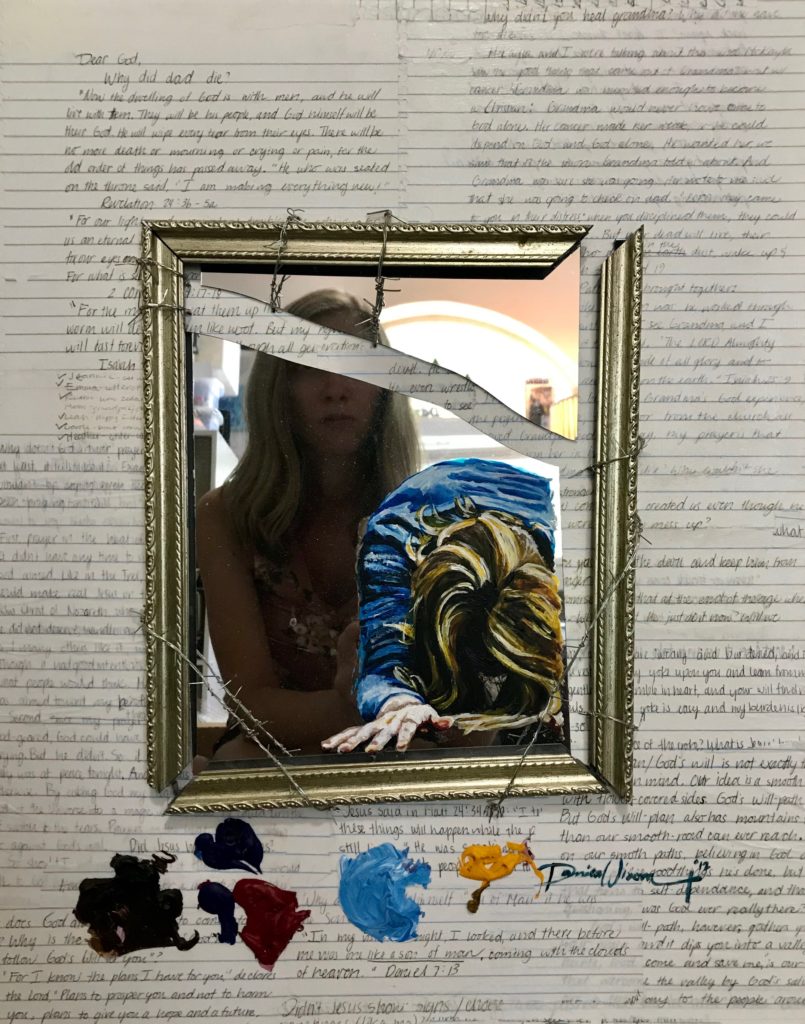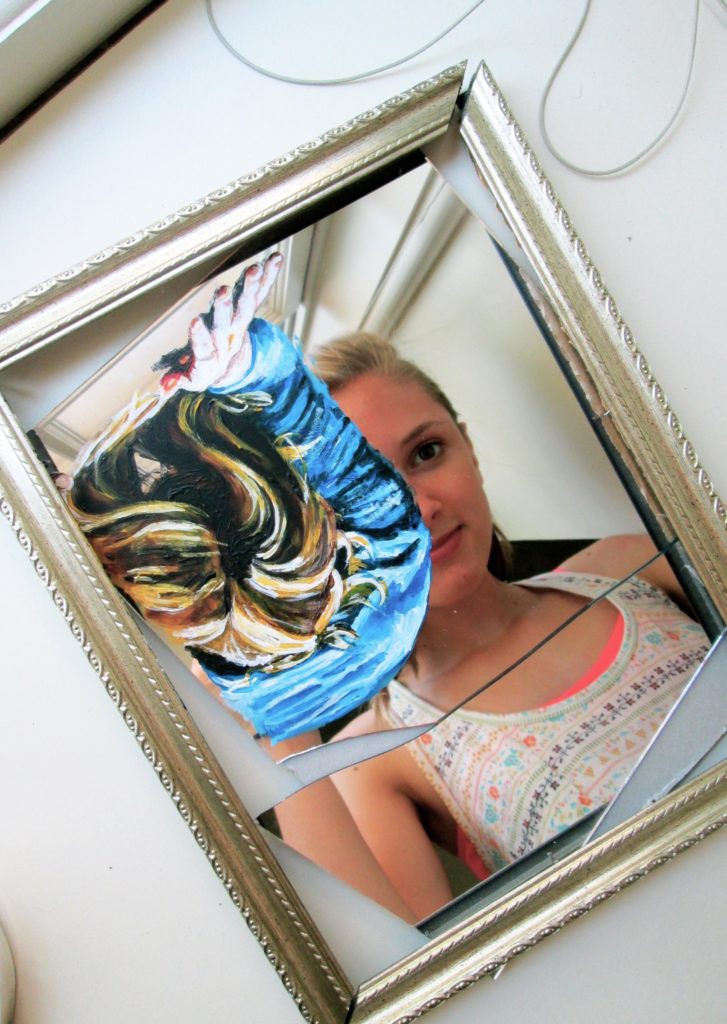
Letting God, Be God, 2012, mixed media on canvas, 24×14”
A mirrored image reflects a girl bowing down, facing away from the viewer. The mirror is cracked, held in place with barbed wire and surrounded by journal pieces and splotches of paint. This artwork is a conceptual piece that explores the age-old questions of suffering and the sovereignty of God.
While I can’t provide satisfying answers, I want to lead you on my journey of discovery as I created this piece.
The mirror with the painting on it used to be whole. It was an art piece in itself called, “Imago – Imago”. The title comes from the Latin word, Imago Dei, speaking of humanity’s creation and purpose being sourced in God himself. He is the Original Image. We are therefore Imago Dei, image-bearers of God.
“Imago – Imago” was created during a time in my life where grief over lost loved ones controlled me. During one of the lowest points in my grief experience I actually watched myself cry in my bedroom mirror. Through prayer and conviction, I realized that grief had become my god. From an artist’s perspective, painting the bowing person in the mirror allows the viewer to ask if they are also bowing down to themselves.
When I brought this mirror piece with me to college in preparation for an art exhibit, I accidentally dropped the mirror, breaking it into several fragments. The significance of this break stunned me because it echoed what had also occurred in my soul. Instead of seeing a broken piece of art, I saw the opportunity to create a new art piece about its breaking.

Artwork by Danica Thurber
After all, “Imago – Imago” is a distortion of the way we were made. It is self-worship, as bizarre and futile as a painting in a museum falling in love with its’ reflection in a window.
Before I explain the next step of the painting I want to pause and ask, why would we make an idol out of our pain? I have a hunch that it happens all the time.
For me, it began when I lost my dad when I was twelve. Only a few months later, my grandma was diagnosed with a rare cancer. My mom was preoccupied caring for my grandma, who passed within a year and a half of dad’s death. My world was new, strange, and terrifying. I felt so alone.
Idolizing my pain was a gradual process, so gradual in fact, that I didn’t realize I had become a slave to it. By the time I sought out counseling, my pain had become so familiar that it was a sort of comfort to me. It became my identity; I didn’t know who I was apart from it.
Most notably, however, idolizing my pain allowed me to justify myself as a “victim”. Pay attention (or maybe, ‘Listen here’ or ‘The following are some of the’…) to the whispered lies (I heard during that time)—maybe you can relate to some of them.
I used my victim status against:
-
Others
(“Your pain isn’t as bad as mine.”)
-
Myself
(I am nothing but pain. It’s all I will ever be.”)
-
God
(“You could have prevented this pain and yet you didn’t. I am justified in my keeping my distance from you.”)
My broken artwork called “Imago – Imago” symbolizes my previous victim-hood coming to its’ broken end. I added barbed wire to hold the mirror pieces apart (or together?). The barbed wire is like a crown of thorns. It symbolizes Jesus who went through unimaginable suffering on my behalf. He was called a man of suffering, familiar with pain (Isaiah 53). In fact, his last words on the cross echoed mine, “My God, my God, why have you forsaken me?”.
Did you know that God isn’t afraid of our “why” questions? Through Jesus, I saw that God was not unaware of my grief, indeed, it grieves Him to see His loved ones in pain.
It was time for me to give up my demand for answers. The background of the new artwork is made from a “Question Notebook” that I started as a young, struggling teenager. It contains questions such as, “Why did dad die?” and, “Why didn’t you heal grandma?” along with my attempted answers.
The questions became a canvas for the new creation I was becoming amidst the brokenness.
Not surprisingly, the “Question Notebook” didn’t get me very far in life. And even art couldn’t give me the answers or the comfort I was seeking. The paint blotches below the mirror represent my quest for answers through painting.

Letting God, Be God, 2012, mixed media on canvas, 24×14”
Running around with the questions we have inside ourselves only makes us blind and dizzy. Believe me, I know. The only way out of this tangled mess is to stop demanding answers, to stop bowing down to our brokenness. We can learn to accept that bad things happen, simply as a side effect of the broken world we live in.
It’s not supposed to be this way; that’s why it hurts so much.
There’s nothing wrong with asking “why?”; I believe it’s a part of the grief process. But when questioning starts to get old, what if we begin trading our “Why?” for “Ok, what now?”
Like my broken mirror, we can look at the mess of our lives and prayerfully ask,
“God, what can we create from this?”
Danica has created an online course where you can learn more about using art as a tool in your grief process. Ten art projects help you change your perspective from that of the “grief victim” (someone who lets grief happen to them) to that of the “grief ARTIST” (someone who takes grief and makes something beautiful out of it). Learn more at: https://projectgrief.org

About Danica // When I was twelve years old, my dad passed away of a sudden heart attack. I struggled to
understand and express my grief for many years afterward and art was sometimes my only outlet for grief. I graduated from Washington State University with a thesis on “Cultural Expressions of Grief Through Art”, receiving high honors and being the first to combine an academic project with an art project. My thesis was published in an online journal and I have spoken at multiple conferences nationwide and led grief art workshops throughout the Northwest. I created Project Grief out of my own research and experiences with the arts and mental wellness. Project Grief is an online school that teaches others how to use art as a therapeutic tool in their grief process. To find out more, visit: https://www.projectgrief.org
